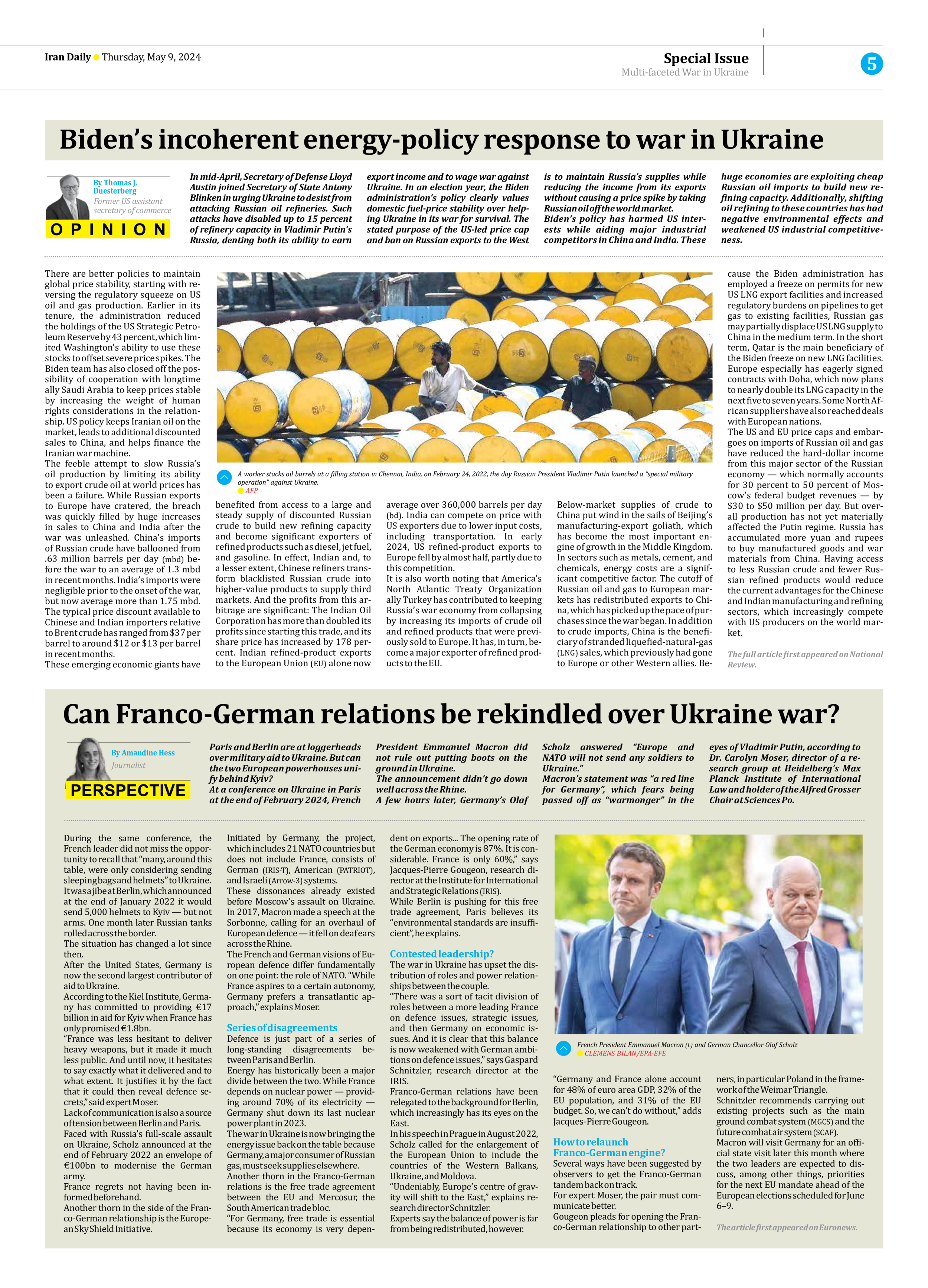
Biden’s incoherent energy-policy response to war in Ukraine
In mid-April, Secretary of Defense Lloyd Austin joined Secretary of State Antony Blinken in urging Ukraine to desist from attacking Russian oil refineries. Such attacks have disabled up to 15 percent of refinery capacity in Vladimir Putin’s Russia, denting both its ability to earn export income and to wage war against Ukraine. In an election year, the Biden administration’s policy clearly values domestic fuel-price stability over helping Ukraine in its war for survival. The stated purpose of the US-led price cap and ban on Russian exports to the West is to maintain Russia’s supplies while reducing the income from its exports without causing a price spike by taking Russian oil off the world market. Biden’s policy has harmed US interests while aiding major industrial competitors in China and India. These huge economies are exploiting cheap Russian oil imports to build new refining capacity. Additionally, shifting oil refining to these countries has had negative environmental effects and weakened US industrial competitiveness.
By Thomas J. Duesterberg
Former US assistant
secretary of commerce
There are better policies to maintain global price stability, starting with reversing the regulatory squeeze on US oil and gas production. Earlier in its tenure, the administration reduced the holdings of the US Strategic Petroleum Reserve by 43 percent, which limited Washington’s ability to use these stocks to offset severe price spikes. The Biden team has also closed off the possibility of cooperation with longtime ally Saudi Arabia to keep prices stable by increasing the weight of human rights considerations in the relationship. US policy keeps Iranian oil on the market, leads to additional discounted sales to China, and helps finance the Iranian war machine.
The feeble attempt to slow Russia’s oil production by limiting its ability to export crude oil at world prices has been a failure. While Russian exports to Europe have cratered, the breach was quickly filled by huge increases in sales to China and India after the war was unleashed. China’s imports of Russian crude have ballooned from .63 million barrels per day (mbd) before the war to an average of 1.3 mbd in recent months. India’s imports were negligible prior to the onset of the war, but now average more than 1.75 mbd. The typical price discount available to Chinese and Indian importers relative to Brent crude has ranged from $37 per barrel to around $12 or $13 per barrel in recent months.
These emerging economic giants have benefited from access to a large and steady supply of discounted Russian crude to build new refining capacity and become significant exporters of refined products such as diesel, jet fuel, and gasoline. In effect, Indian and, to a lesser extent, Chinese refiners transform blacklisted Russian crude into higher-value products to supply third markets. And the profits from this arbitrage are significant: The Indian Oil Corporation has more than doubled its profits since starting this trade, and its share price has increased by 178 percent. Indian refined-product exports to the European Union (EU) alone now average over 360,000 barrels per day (bd). India can compete on price with US exporters due to lower input costs, including transportation. In early 2024, US refined-product exports to Europe fell by almost half, partly due to this competition.
It is also worth noting that America’s North Atlantic Treaty Organization ally Turkey has contributed to keeping Russia’s war economy from collapsing by increasing its imports of crude oil and refined products that were previously sold to Europe. It has, in turn, become a major exporter of refined products to the EU.
Below-market supplies of crude to China put wind in the sails of Beijing’s manufacturing-export goliath, which has become the most important engine of growth in the Middle Kingdom. In sectors such as metals, cement, and chemicals, energy costs are a significant competitive factor. The cutoff of Russian oil and gas to European markets has redistributed exports to China, which has picked up the pace of purchases since the war began. In addition to crude imports, China is the beneficiary of stranded liquefied-natural-gas (LNG) sales, which previously had gone to Europe or other Western allies. Because the Biden administration has employed a freeze on permits for new US LNG export facilities and increased regulatory burdens on pipelines to get gas to existing facilities, Russian gas may partially displace US LNG supply to China in the medium term. In the short term, Qatar is the main beneficiary of the Biden freeze on new LNG facilities. Europe especially has eagerly signed contracts with Doha, which now plans to nearly double its LNG capacity in the next five to seven years. Some North African suppliers have also reached deals with European nations.
The US and EU price caps and embargoes on imports of Russian oil and gas have reduced the hard-dollar income from this major sector of the Russian economy — which normally accounts for 30 percent to 50 percent of Moscow’s federal budget revenues — by $30 to $50 million per day. But overall production has not yet materially affected the Putin regime. Russia has accumulated more yuan and rupees to buy manufactured goods and war materials from China. Having access to less Russian crude and fewer Russian refined products would reduce the current advantages for the Chinese and Indian manufacturing and refining sectors, which increasingly compete with US producers on the world market.
The full article first appeared on National Review.







